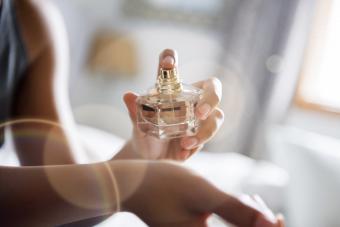
Good nail care yields strong, healthy, beautiful nails. A little time and effort can go a long way in creating gorgeous nails you'll be proud of.
Protecting Your Nails
One important aspect of maintaining your nails is to protect your nails and prevent damage from occurring.
Water and Your Nails
Submerging your nails in water for long periods of time can be very damaging. Nails are weakened and more easily peeled, split, or broken when overexposed to water.
For good nail care protection against water:
- Limit the amount of time your hands spend immersed in water.
- Wear gloves when washing dishes.
- When cleaning nails, soak them no longer than a few minutes to loosen dirt and debris from under the nail.
- Wear a clear nail hardener or nail polish to make bare nails more resistant to water.
Chemicals
Many of the everyday products we use contain chemicals that are potentially damaging to the nails. If your nails do become stained from cleaning or household products, soaking them in a bowl of warm water and lemon juice for a few minutes may help remove the stain.To keep the damaging effects of chemicals at bay:
- Always wear gloves when using cleaning products, bleach, solvents, or other household chemicals.
- Try to avoid allowing face products designed for acne or oily skin to get on nails, as these will strip natural moisture from the nails and contribute to dryness and fragility.
- Use only non-acetone nail polish remover in your nail care routine.
- Use nail polish remover infrequently as it is a powerful and drying chemical.
Gentle Use
Another cause of nails splitting, cracking, and breaking is aggressive use of the nails. Treat nails gently to avoid damage. Open soda cans, bottles, or other containers with a butter knife or bottle opener rather than your nails. Open letters with a letter opener or knife, not your nails. Wear gloves when gardening and doing yard work, and avoid scraping, picking, or prying things off or open with your nails.
Healthy Nails
- In addition to preventing damage to your nails, good nail care starts from the inside out. Drinking plenty of water and eating a healthy diet containing the right amounts of protein and calcium can help foster strong and healthy nails.
- A substance called biotin, available as a dietary supplement in health food and nutrition stores, is thought to contribute to healthy nails. Vitamin E is also thought to encourage strong nails and hair.
- To help stimulate blood flow to the nail bed, massage your nails with hand cream or massage oil. Keep nails at a reasonable length to keep them from getting caught and tearing.
Dealing with Torn or Broken Nails
If your nail does get torn or broken, you can often simply clip the nail, file it smooth, and allow it to regrow. If it is badly broken and will be painful, most nail salons will repair the nail for a minimal fee. Alternately, there are over the counter nail products, such as Orly Nail Rescue, that can be used at home to repair the nail.
Basic Nail Care
Basic nail care includes cleaning, trimming, filing, and buffing your nails. You can either do these steps at home, or visit a profession nail salon. There is no set rule for how often to manicure your nails, but in general it should not be done more than once per week.
Cleaning
To clean under and around your nails, use a nail brush with natural boar or plastic bristles with a gentle soap and water. The bristles should be firm enough to remove dirt and debris, but not so stiff that they are harsh on the skin around the nails.
Soak nails for a few minutes in a bowl of warm water to loosen the dirt, and then gently remove with the nail brush.
Trimming
Trimming nails can keep them looking clean and at a manageable length. Choose a nail length that's appropriate for you -- for most women, active and medium lengths work best. To trim long nails, use a pair of sharp nail clippers and clip nails straight across.
Filing
Filing is an important part of nail care. It smoothes and shapes nail tips to keep them looking beautiful. Filing can also remedy small snags and rips in a nail to keep a nail from further tearing. For best results, use a fine grade wooden nail file or emery board. File in one direction and avoid filing down the sides of nails.
Buffing
Buffing nails encourages blood flow to the nail bed and creates a smooth, shiny, and healthy looking nail surface. Use a fine buffer rather than a coarse buffer on nails. Buffing can be done on bare nails or over polish, but use care over bare nails. Buff gently and down in one direction.
Cuticle Care
Another important part of nail care is proper cuticle treatment. Soften and moisturize cuticles with hand cream, lotion, or cuticle softener or oil. Use an orange wood or birchwood stick to gently push back cuticles. Take care not to push the cuticle back too far.
Nail Polish
Nail polish may not be a necessity, but it plays an important part in the world of nail care. In addition to acting as an accessory and fashion statement for your nails, polish can also benefit your nails by providing a protective layer against water and other agents.
Whether you go with a clear or natural looking polish or a bright red or eye-catching blue, polish can also help give nails a clean, crisp, finished look.
There is a wide variety of nail polishes on the market today, including:
- Quick-dry polishes
- Nail strengtheners
- Grrowth formulas
- All-in-one formulas containing top coat, base coat, and color in one polish
- Chip resistant polishes
- Extended wear polishes
For best results, use a good quality nail polish, such as OPI, with a professional applicator to distribute the color evenly. Limit nail polish changes to keep polish remover from frequent contact with the nails.
Maintain Good Nail Health
Tidy nails will help create an overall attractive personal appearance. Besides looking good, proper nail maintenance will keep your nails healthy.







